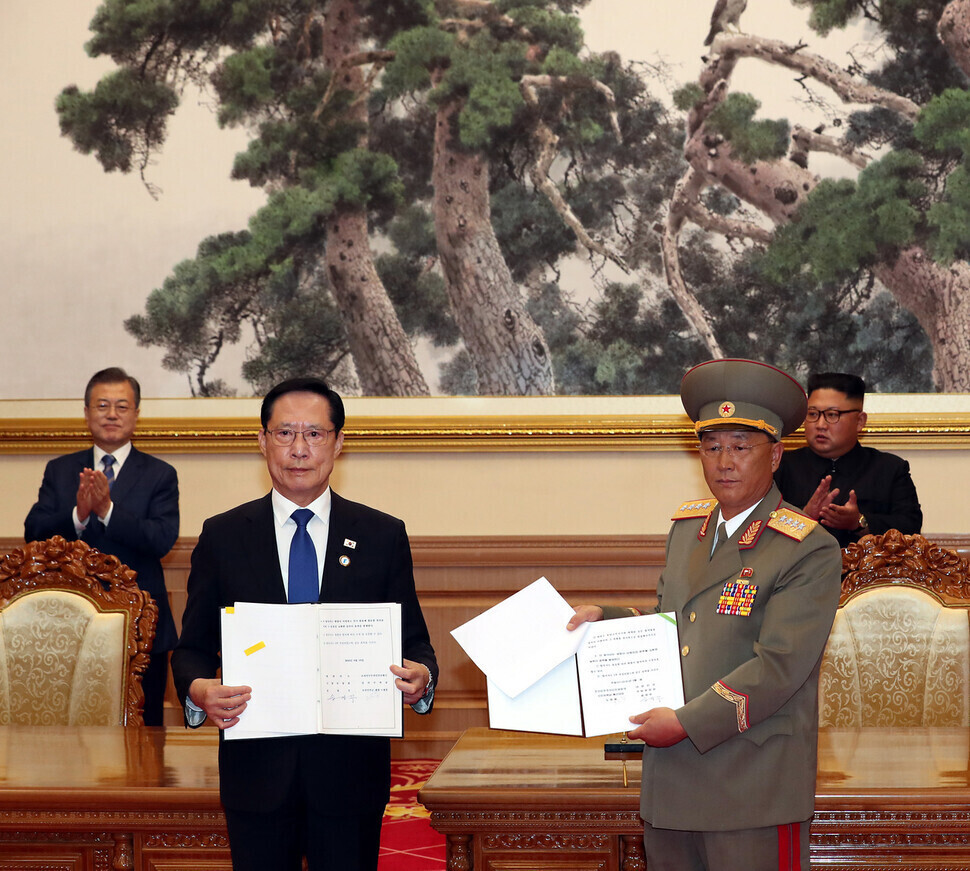hankyoreh
Links to other country sites 다른 나라 사이트 링크
Explainer: What exactly is the inter-Korean military pact that might be suspended?

In Pyongyang on Sept. 19, 2018, the defense ministers of South and North Korea signed the “Agreement on the Implementation of the Historic Panmunjom Declaration in the Military Domain” as part of the Pyongyang Joint Declaration.
At the heart of the agreement, known colloquially as the Sept. 19 military agreement, was the establishment of buffer zones on the land, in the sea and in the air between the two Koreas and a suspension of hostile activities.
The agreement included the suspension of mutually hostile activities, demilitarization of the Joint Security Area (JSA), trial removal of guard posts inside the DMZ, joint recovery of Korean War remains, and shared use of the Han River estuary.
On the ground, the two sides agreed to completely cease artillery drills and field training exercises at the regimental level and above within 5 kilometers (3 miles) of the Military Demarcation Line (MDL).
At sea, the two sides installed covers on the barrels of naval guns and coastal artillery and closed gunports in a buffer zone north of Deokjeok Island and south of Cho Island off the peninsula’s western coast and north of Sokcho and south of Tongcheon on the eastern coast.
They also ceased all live-fire and maritime maneuver exercises within the zone.
In the air, the two Koreas established no-fly zones for different kinds of aircraft along the MDL.
For unmanned aerial vehicles (UAVs), the no-fly zone is set at 15 kilometers from the MDL in the east and 10 kilometers in the west.
The intrusion of five UAVs into the airspace above the greater Seoul area on Dec. 26 violated the comprehensive military agreement.
South Korea’s Ministry of National Defense said North Korea has violated the Sept. 19 military agreement 17 times so far.
South Korea has violated the Sept. 19 military agreement twice while responding to North Korean violations.
After the intrusion of the North Korean UAVs on Dec. 26, South Korea sent a UAV north of the MDL.
Likewise, after a North Korean missile crossed south of the maritime demarcation line in the East Sea on Nov. 2, South Korean warplanes fired three air-to-ground missiles into open waters north of the maritime demarcation line.
By Kwon Hyuk-chul, staff reporter
Please direct questions or comments to [english@hani.co.kr]

Editorial・opinion
![[Guest essay] Maybe Korea’s rapid population decline is an opportunity, not a crisis [Guest essay] Maybe Korea’s rapid population decline is an opportunity, not a crisis](https://flexible.img.hani.co.kr/flexible/normal/500/300/imgdb/original/2024/0430/9417144634983596.jpg) [Guest essay] Maybe Korea’s rapid population decline is an opportunity, not a crisis
[Guest essay] Maybe Korea’s rapid population decline is an opportunity, not a crisis![[Column] Can Yoon steer diplomacy with Russia, China back on track? [Column] Can Yoon steer diplomacy with Russia, China back on track?](https://flexible.img.hani.co.kr/flexible/normal/500/300/imgdb/original/2024/0430/1617144616798244.jpg) [Column] Can Yoon steer diplomacy with Russia, China back on track?
[Column] Can Yoon steer diplomacy with Russia, China back on track?- [Column] Season 2 of special prosecutor probe may be coming to Korea soon
- [Column] Park Geun-hye déjà vu in Yoon Suk-yeol
- [Editorial] New weight of N. Korea’s nuclear threats makes dialogue all the more urgent
- [Guest essay] The real reason Korea’s new right wants to dub Rhee a founding father
- [Column] ‘Choson’: Is it time we start referring to N. Korea in its own terms?
- [Editorial] Japan’s rewriting of history with Korea has gone too far
- [Column] The president’s questionable capacity for dialogue
- [Column] Are chaebol firms just pizza pies for families to divvy up as they please?
Most viewed articles
- 1First meeting between Yoon, Lee in 2 years ends without compromise or agreement
- 2Under conservative chief, Korea’s TRC brands teenage wartime massacre victims as traitors
- 3[Guest essay] Maybe Korea’s rapid population decline is an opportunity, not a crisis
- 4Months and months of overdue wages are pushing migrant workers in Korea into debt
- 5[Column] Can Yoon steer diplomacy with Russia, China back on track?
- 6After election rout, Yoon’s left with 3 choices for dealing with the opposition
- 7‘We must say no’: Seoul defense chief on Korean, USFK involvement in hypothetical Taiwan crisis
- 8Two factors that’ll decide if Korea’s economy keeps on its upward trend
- 9Dermatology, plastic surgery drove record medical tourism to Korea in 2023
- 10[Editorial] Japan’s rewriting of history with Korea has gone too far